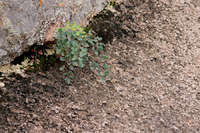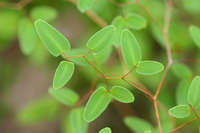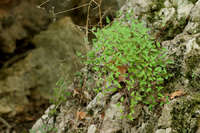Stems creeping, horizontal, slender, 2--5 mm diam.; scales mostly bicolored, lanceolate, largest scales 0.3--0.8 mm wide, centers black, thick, margins brown, thin, erose-dentate. Leaves monomorphic, clustered or scattered along stem, 15--100 cm; croziers pubescent, bearing a few scales. Petiole straw-colored, tan, or gray, not lustrous, rounded or slightly flattened adaxially, without prominent articulation lines. Blade elongate-deltate, usually 3-pinnate proximally, 5--25 cm wide; rachis tan throughout, strongly flexuous, rounded or flattened adaxially, usually glabrous. Pinnae retrorse, projecting downward toward base of leaf, not decurrent on rachis, with 5--40 ultimate segments; costae strongly flexuous, 25--120 mm, longer than ultimate segments. Ultimate segments lanceolate-deltate, 5--20 mm, leathery, glabrous or sparsely pubescent; margins recurved on fertile segments, covering less than 1/2 abaxial surface, borders whitish, entire; apex obtuse to truncate. Veins of ultimate segments obscure. Sporangia short-stalked, containing 64 spores, not intermixed with farina-producing glands. 2 n = 58.
Sporulating summer--fall. Rocky slopes and ledges, leaves often supported by associated vegetation, on a variety of substrates including granite and limestone; 300--1700 m; Tex.; Mexico; West Indies in Hispaniola; Central America; South America.
Populations of Pellaea ovata in the flora are composed of sexual diploids; an apogamous triploid cytotype predominates south of the United States. I have not seen herbarium specimens to substantiate reports of P . ovata from New Mexico (D. B. Lellinger 1985).
Common Name: ovateleaf cliffbrake
Etymology: Pellaea is from the Greek pellaios, dark, alluding to the stalk,
Synonyms: None






